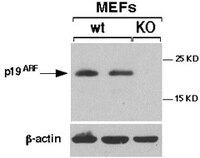PC435 Sigma-AldrichAnti-p19ARF (54-75) (Ab-1) Rabbit pAb
This Anti-p19ARF (54-75) (Ab-1) Rabbit pAb is validated for use in Immunoblotting for the detection of p19ARF (54-75) (Ab-1).
More>> This Anti-p19ARF (54-75) (Ab-1) Rabbit pAb is validated for use in Immunoblotting for the detection of p19ARF (54-75) (Ab-1). Less<<Productos recomendados
Descripción
| Replacement Information |
|---|
Tabla espec. clave
| Species Reactivity | Host | Antibody Type |
|---|---|---|
| M | Rb | Polyclonal Antibody |
| Product Information | |
|---|---|
| Form | Liquid |
| Formulation | In PBS, 1% BSA. |
| Positive control | Mouse embryo fibroblasts or CTLL2 cells |
| Preservative | ≤0.1% sodium azide |
| Quality Level | MQ100 |
| Physicochemical Information |
|---|
| Dimensions |
|---|
| Materials Information |
|---|
| Toxicological Information |
|---|
| Safety Information according to GHS |
|---|
| Safety Information |
|---|
| Product Usage Statements |
|---|
| Packaging Information |
|---|
| Transport Information |
|---|
| Supplemental Information |
|---|
| Specifications |
|---|
| Global Trade Item Number | |
|---|---|
| Número de referencia | GTIN |
| PC435 | 0 |
Documentation
Anti-p19ARF (54-75) (Ab-1) Rabbit pAb Ficha datos de seguridad (MSDS)
| Título |
|---|
Anti-p19ARF (54-75) (Ab-1) Rabbit pAb Certificados de análisis
| Cargo | Número de lote |
|---|---|
| PC435 |
Referencias bibliográficas
| Visión general referencias |
|---|
| De Stanchina, E., et al. 1998. Genes Dev. 12, 2434. Larson, C.J., 1998. Bull. Cancer. 85, 304. Radfar, A., et al. 1998. Proc. Natl. Acad Sci USA. 95, 13194. Zindy, F., et al. 1998. Genes Dev. 12, 2424. |


















